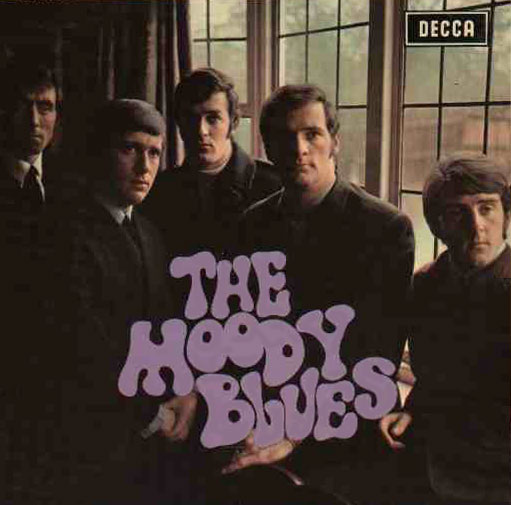
Denny Laine (guitar, vocals)
Michael Pinder (keyboards, vocals)
Ray Thomas (harmonica, saxophone, flute, vocals)
Clint Warwick (bass, vocals)
Graeme Edge (drums)
1964
April The nucleus of the band is formed by Laine (b. Brian Frederick Hines, 29 October 1944, Tyseley, Birmingham, W. Midlands, UK), who has just disbanded his group Denny And The Diplomats, with Thomas (b. 29 December 1942, Stourport-on-Severn, Hereford & Worcs, UK.) and Pinder (b. 27 December 1941, Birmingham, W. Midlands, UK), who have both been playing in local outfits El Riot & The Rebels and The Krewcats, and have just returned from a year’s residence at Hamburg’s Top Ten club.
May (4) Rehearsals begin with the addition of drummer Edge (b. 30 March 1942, Rochester, Staffs, UK), who has previously been a member of Gerry Levene & The Avengers and bass player Clint Warwick (b. Albert Eccles, 25 June 1940, Birmingham, W. Midlands, UK), formerly a member of The Rainbows. The group quickly gains a residency at the Carlton Ballroom in Erdington, West Midlands, initially billed as The M&B Five, apparently in the hope of gaining sponsorship from local brewers Mitchell and Butler. Laine, who has pushed the band’s sound towards the blues and jazz of London based groups, decides soon afterwards to re-name the band after a Slim Harpo song titled “Moody Blue” and The M&B Five becomes The Moody Blues Five.
August The band attracts the attention of London manager Tony Secunda, who secures The Moody Blues (as they now call themselves), a residency at London’s Marquee club on Monday nights, where they replace Manfred Mann. Through their prestigious “live” work at the club, the band quickly attracts the attention of Decca Records which signs the group. Shortly afterwards The Moody Blues record their debut single, the Pinder-Laine composition “Lose Your Money” which the band performs on ITV’s Ready Steady Go!.
September (3) The group plays its first show at the Marquee in London.
(11) The Moody Blues appear at Birmingham’s Town Hall alongside The Spencer Davis Group and headliners Alexis Korner Incorporated.
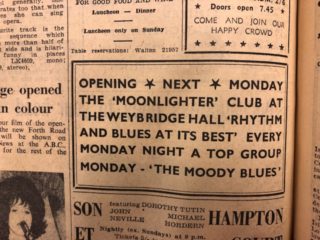
(14) The Moody Blues open the Moonlighter Club, held at Weybridge Hall in Weybridge, Surrey.
(28) The band returns for another show at the Moonlighter Club, Weybridge Hall in Weybridge, Surrey.
October (4) The band plays at the Marquee in London.
(30) The Moody Blues appear at the Crawdaddy club in Richmond, Surrey.
November After “Lose Your Money” fails to chart, the group records a cover of Bessie Banks’s US R&B hit, “Go Now”, which has been given to the band by New York disc-jockey B. Mitchell Reed during a visit to the UK.

(2) The Moody Blues perform again at the Moonlighter Club, held at Weybridge Hall in Weybridge, Surrey.
December (7) The group appears at the Marquee in London.
1965
January (8) The group begins a 24-date, twice-nightly tour with Chuck Berry at the Odeon Theatre, London, which will end 31 January at the Regal Theatre, Edmonton, London.
(28) “Go Now”, produced by Alex Murray, tops the UK chart.
February The band quickly releases “I Don’t Want To Go On Without You”, a revival of a Drifters’ b-side as a follow up single, but it only reaches UK #33. Part of the single’s failure can be attributed to the simultaneous release of identical covers by The Searchers and The Escorts. (The group is unhappy with the recording because Thomas’s flute solo has been inexplicably erased from the final pressing.)
March (8) The Moody Blues make their first live broadcast on BBC Radio’s Joe Loss Pop Show.
April “Go Now” holds down anchor position in a unique US Top 10 in which 9 of the singles are from the UK.
(11) The group takes part in the annual New Musical Express poll winners concert at the Empire Pool, London, with The Beatles, The Rolling Stones, The Kinks and The Animals among others.
May The band releases an EP, which features both sides of the group’s debut single plus the a-sides of the previous two releases.
(24) The Moody Blues take part in the British Song Festival at the Dome, Brighton, East Sussex.
June (5) The band guests on ITV’s Thank Your Lucky Stars, where it introduces its new single, the Pinder-Laine collaboration “From The Bottom Of My Heart”.
(15) The Moody Blues join The Rolling Stones for a 4-date tour of Scotland alongside The Hollies, The Cannon Brothers and The Checkmates. The tour begins at the Odean Theatre, Glasgow.
(16) The group performs at the Usher Hall, Edinburgh.
(17) The Moody Blues appear at the Caird Hall, Dundee.
(18) The final date takes place at the Capitol Theatre, Aberdeen. (While the Stones prepare for a short tour of Scandinavia, The Moody Blues return to London in order to fly to New York for their debut US appearance.)
(19) The group makes its US debut with The Kinks at the Academy of Music in New York.
July “From The Bottom Of My Heart” is released and climbs to UK #22 and US #93. The Moody Blues’ debut album Magnificent Moodies, which has been produced by Denny Cordell is released to coincide with the single but fails to chart. In the US the album is released as Go Now and features a different track listing.
(24) The band performs at the Birdcage in Portsmouth, Hants.
August (1) The Moody Blues perform at the London Palladium with The Rolling Stones, The Fourmost, Steampacket and others.
(6) The group plays on the opening day of the fifth annual National Jazz & Blues Festival at the Richmond Athletic Ground, Richmond, Surrey.
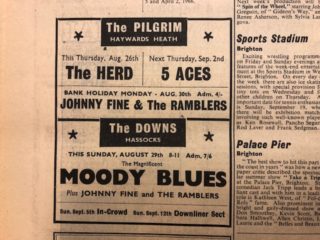
(29) The Moody Blues play at the Downs, Hassocks, West Sussex.
September (6) The band signs a management contract with NEMS.
(21) The Moody Blues participate in Pop From Britain concert at the Royal Albert Hall, London, with Cliff Bennett & The Rebel Rousers, Georgie Fame & The Blue Flames and The Fourmost.
(25) The group appears at the Birdcage in Portsmouth, Hants with St Louis Checks.
(30) The Moody Blues replace Unit 4 Plus 2 for 3 dates on The Rolling Stones UK tour. The first date takes place at the Gaumont Theatre, Hanley, Staffs. Also on the tour are The Spencer Davis Group, The End and The Habits.
October (1) The band appears at the ABC Theatre, Chester, Cheshire.
(2) The group’s final appearance takes place at the ABC Theatre, Wigan, Lancashire. Unit 4 Plus 2 return to the tour immediately afterwards.
November The Laine-Pinder composition “Everyday” only reaches UK #44, despite becoming a turntable hit on pirate radio.
December (3) The group supports The Beatles on their final UK tour, a 9-date twice-nightly package, which opens at Glasgow’s Odeon cinema and ends on December 12 at the Capitol Cinema, Cardiff, Wales.
(19) The Moody Blues appear on CBS TV’s Ed Sullivan Show.
1966
March (8) The group appears at the Montreux Golden Rose TV festival.
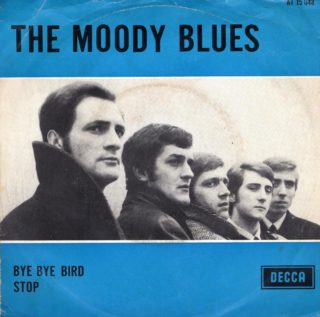
April Another Laine-Pinder track “Stop!” is lifted from the UK album and released as a US single, where it spends a week on the Hot 100 at #98. (The song incidentally, is later covered by singer Julie Grant but is not a success). Secunda leaves at this point to work with The Move and is replaced by The Beatles’ manager Brian Epstein. However, he fails to lift the group’s flagging career and as a result The Moody Blues are forced to “drastically reduce their engagement fees.”
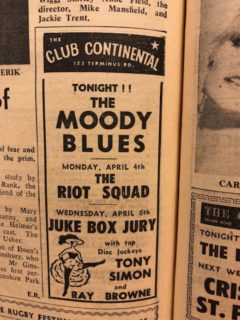
(2) The Moody Blues appear at the Club Continental, Eastbourne, East Sussex.
May (1) The band performs at the Oasis in Manchester.
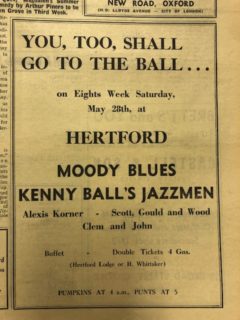
(28) The Moody Blues appear at Hertford Ball, Hertford College, Oxford University with Kenny Ball’s Jazzmen, Alexis Korner, Scott, Gould & Wood, Clem and John.
(30) The group plays at the Pavilion in Bath, Avon.
June (4) Melody Maker announces that the group has undertaken a short tour of Belgium, including a TV appearance from the Casino at Knokke. The magazine also reports that the band is due to appear at the Paris Olympia on 12 June.
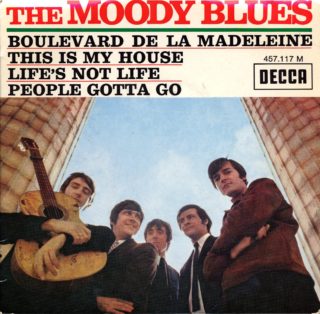
(15) The Moody Blues perform at the Bromel club, the Bromley Court Hotel, Kent.
(24) The group plays at the Ram Jam club in Brixton in south London. Warwick, who is disillusioned by the band’s drop in fortunes, leaves the group and quits the music business.
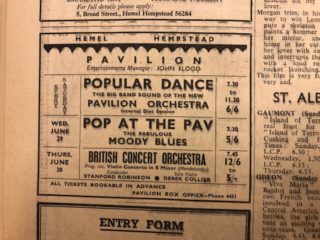
(29) The Moody Blues appear at the Pavilion, Hemel Hempstead, Herts.
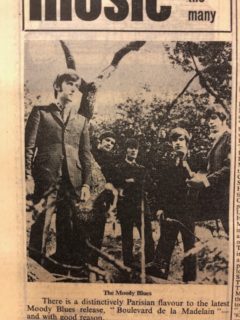
July (9) Pinder and Laine’s “This Is My House (But Nobody Calls)” (the intended b-side of the band’s forthcoming UK single) is issued in the US hitting #119.
(14) After Klaus Voorman decides not to join, Rod Clark, a bass player from Great Yarmouth, who has played with Les Garcons takes Warwick’s place, although Pinder and Thomas’s former El Riot & The Rebels cohort John Lodge (b. 20 July 1943, Birmingham, W. Midlands, UK) is rumoured to have been offered the original slot. Clark debuts at the Villa Marina in Coventry.
(30) The group appears at the Riverside Dance Club in Douglas, the Isle of Man.
August (6) The Moody Blues begin a 9-day tour of Denmark.
(20) The group appears at Town Hall, Clacton, Essex with Dave & The Strollers.
September (3) The band appears at the Black Prince in Tenbury Wells.
(10) Melody Maker reports that The Moody Blues fly to Holland for a TV show and then the next day perform in Brussels.
(15) The band plays at the Jaarbeurs in Utrecht, Holland.
(16) The Moody Blues perform at Midnight City in Birmingham with Cliff Bennett & The Rebel Rousers.
(23) The group appears at Cardiff Capitol Theatre on a bill that includes Cliff Bennett & The Rebel Rousers, The Scaffold and The Fourmost.
(28) The Moody Blues appear at the Flamingo in London in what is probably Denny Laine’s final show.
October Rod Clark leaves to join The Rockin’ Berries and John Lodge joins. Lodge, who has remained in higher education since the band’s split in February 1963, has subsequently played in local bands The Carpetbaggers and The John Bull Breed. Laine, meanwhile, anticipating Brian Wilson’s role in The Beach Boys decides to concentrate on writing and studio work.
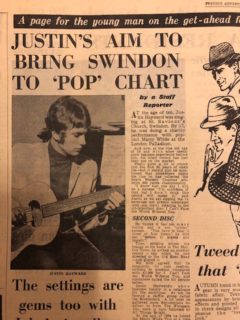
(8) Record Mirror reports that Laine has officially left The Moody Blues. He will quickly emerge with an amplified backing group The Electric String Band – a predecessor and major influence on The Electric Light Orchestra.
(12) Decca releases the group’s first single in over a year, the French-flavoured “Boulevard De La Madelaine”, written by Pinder and Laine but it isn’t a hit. On the same day, Melody Maker reports that the band appears at the Flamingo in London. To fill Laine’s position in the band, the group turns to Justin Hayward (b. David Justin Hayward, 14 October 1946, Swindon, Wilts, UK), who has played in a number of Swindon bands – The Riversiders, The Rebels, The Whispers, The Shots and All Things Bright before joining Marty Wilde’s Wildcats for two days. He then joins Marty Wilde and his wife in The Marty Wilde Three, who record the singles “Since You’ve Gone” and “I Cried” for Decca Records and on 8 April 1966 plays alongside Wilde at a charity show at the London Palladium. Hayward leaves to sign a solo deal with Pye A&R chief Alan Freeman and manager Lonnie Donegan. This results in a one-off single “London Is Behind Me”, before Hayward signs to Parlophone, which releases a second single “I Can’t Face The World Without You”. When both singles fail, Hayward writes to Eric Burdon to inquire about a position in his New Animals. Burdon, with his band already signed-up, passes Hayward’s name onto Mike Pinder. The Moody Blues move to Belgium in November to perform some gigs and to avoid the UK taxman. The band continues to perform its old R&B repertoire despite Laine’s departure and the recent changes in the UK “music scene”.
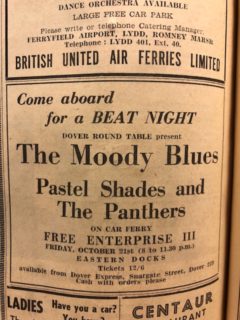
December The group performs in France, where it’s still very popular.
1967
January (14) Decca releases another Pinder-Laine collaboration “Life’s Not Life”, which is withdrawn shortly afterwards.
February (18) The group appears at the Plaza Ballroom in Handsworth, West Midlands with The Traction and The Attack.
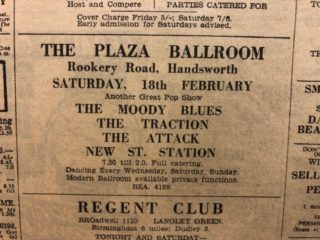
March (7) The Moody Blues play at Birmingham’s Ringway Club.
(18) The group performs at the Ritz Club, Skewen, south Wales with The King Bees and The Outer Limits.
(20) The band appears at the Broadway Club, Dudley Zoo.
(22) The Moody Blues play at Middle Earth in London.
(27) The band plays two shows in the West Midlands. The first is at the Mackadown, Kitts Green with The Monopoly. The second is at the Belfry, Wishaw with The Gods and Exception.
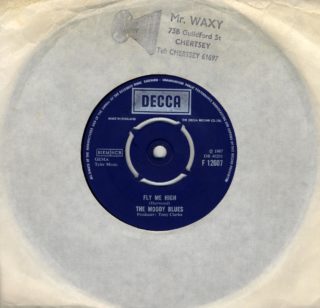
(30) The group drops the old repertoire (and suits) in favour of a new musical style. The band records Hayward’s “Fly Me High” and Pinder’s “Really Haven’t Got The Time” with new producer Tony Clarke as a prospective single.
April The band signs up (along with The Supremes and Ray Charles) to promote Coca-Cola in the teen market. The company’s $10 million campaign requires each artist to record a radio jingle in their own style but featuring the slogan Things Go Better With Coke. The band embarks on a gruelling tour of the Northern club circuit, including a spot at Newcastle’s Cavendish club.
(1) The band appears at the Royal Lido, Prestatyn, Clwyd, Wales with The Raynes.
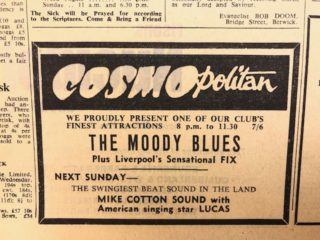
(2) The Moody Blues play at the Cosmo in Carlisle, Cumbria with The Fix.
(14) Denny Laine releases his debut single with The Electric String Band “Say You Don’t Mind” which fails to chart; although ex-Zombies singer Colin Blunstone will later score a top 20 hit with it in 1972.
May (5) The Moody Blues release their first single with the new line-up, “Fly Me High” which is not a success despite being a popular radio hit. The band embarks on a brief tour of Scandinavia.
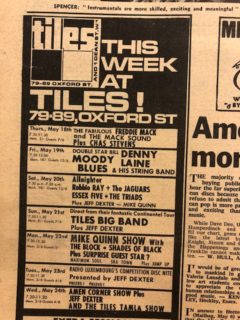
(19) The band shares a double bill with former group leader Denny Laine at London club, Tiles.
(27) Plans are unveiled for the group to appear on a US colour TV special as “Fly Me High” is given an American release.
June (10) They play the Fete and Donkey Derby in Sutton Coldfield, West Midlands with The Ugly’s and The Bobcats.
(12) The Moody Blues appear at Christ College, Cambridge with The Who and The Herd.
(22) The band appears at Middle Earth with Pink Floyd.
(29) The group records Hayward’s “Leave This Man Alone”.
July (9) The band plays at the Roundhouse with Pink Floyd and The Outer Limits.
(17) The Moody Blues record Pinder’s ambitious “Love & Beauty”, which is the first track to feature the band’s characteristic symphonic sound, created with the use of the mellotron. Shortly afterwards the band introduces its new style at the Glastonbury Festival and is an immediate success.
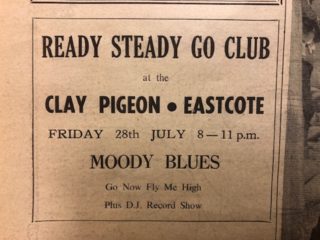
(28) The Moody Blues appear at the Clay Pigeon in Eastcote, northwest London.
(29) The group performs at the London club, the Upper Cut with The Maze.
August The Moody Blues embark on a “summer” tour of France. The group appears at the Midem Music Festival in Cannes performing most of the songs that will subsequently appear on its forthcoming album.
September (7) The group opens for The Pink Floyd at the Roundhouse, Chalk Farm, London.
(13) The band appears at the Catacombe in Eastbourne, East Sussex.
(22) The Moody Blues release Pinder’s “Love & Beauty” as a single, but it isn’t a hit.
October (8) Signed to Decca’s new progressive label, Deram, the band begins work on its first album in over two years, recording Hayward’s epic “Nights In White Satin”. The group were originally invited to record a stereo version of Dvorak’s New World Symphony with classical backing from The London Festival Orchestra, conducted by Peter Knight, but is allowed to record its stage show, loosely based around a day in the life of a fictional character, instead.
1968
January Extracted from the album, Hayward’s “Nights In White Satin” climbs to UK #19 as parent album reaches #27.
(12) Laine meanwhile, disbands The Electric String Band after his second solo single “Too Much In Love” and moves to Spain to study flamenco guitar.
(19) The Moody Blues play at the Punch Bowl, Lapworth, West Midlands.
(20) The group travels to France to appear at the Midem Music Festival in Cannes, later that week.
February (3) The Moody Blues begin a UK tour at the Nelson Imperial, Lancashire. The tour will conclude at Reading University on March 15.
(10) In the US “Nights In White Satin” only reaches #103.
March (13) The group appears at Birmingham Town Hall with The Spencer Davis Group, Manfred Mann, Don Partridge and Piccadilly Line.
(22) The Moody Blues perform at Middle Earth, Covent Garden, London.
May (4) Days Of Future Past enters the US chart at #3 and earns the group its first gold disk, during a chart run of 102 weeks.
June Hayward’s “Voices In The Sky” is lifted from the band’s forthcoming album and reaches UK #27.
(29) The Moody Blues make a rare concert appearance at London’s Queen Elizabeth Hall.
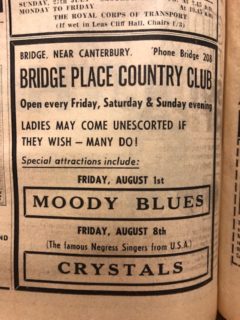
August The group’s third album, In Search Of The Lost Chord, another concept album, climbs to UK #5. (The band is performing in the former Czechoslovakia at the time and when the Russian army moves in are quickly asked to leave the country by the British Consulate.)
September Hayward’s “Tuesday Afternoon” is taken from Days Of Future Past and belatedly released as a US single, where it hits #24. In Search Of A Lost Chord, rises to US #23 and earns a second gold disk.
October (4) The Moody Blues play at the Corn Exchange, Braintree, Essex.
(11) The group records non-album track “A Simple Game”, written by Mike Pinder.
(21-24) The band is supported by Chicago at the Fillmore West, San Francisco.
(25-26) The group flies to New York City to appear at the Fillmore East with John Mayall’s Bluesbreakers and Rhinoceros.
November (1) Having supported Cream during their final US tour, the group appears at Madison Square Gardens, New York, for Cream’s final US date. “Ride My See Saw”, written by Lodge, is extracted from the new album and makes US #61.
December “Ride My See Saw” hits UK #42. The single’s b-side “A Simple Game” is later a UK #3 for The Four Tops with Clarke producing. (The Four Tops will also cover another Mike Pinder song, “So Deep Within You” from The Moody Blues’ next album). The band performs its last US dates in Vancouver, Canada.
1969
March (11) The group appears at the Grand Gala Du Disque, Amsterdam, Holland on a bill including Gladys Knight & The Pips.
April Hayward’s “Never Comes The Day” is released as a single but fails to chart.
May On The Threshold Of A Dream tops the UK chart for 2 weeks and climbs to US #20 during a 136-week chart run, the Moody Blues’ third gold disk.
(2) The band appears at Bridge Place Country Club, at Bridge near Canterbury, Kent.
July “Never Comes The Day” reaches US #91. Denny Laine meanwhile returns from Spain and joins ex-Move member Trevor Burton in Balls.
August (1) The band appears at Bridge Place Country Club, at Bridge near Canterbury, Kent.
(30) The Moody Blues play on the opening day of the Isle Of Wight Festival.
October Hayward and Thomas’s “Watching And Waiting” is the first single to be released on the group’s own Threshold label.
December The Moody Blues’ new album To Our Children’s Children’s Children hits UK #2 as the band moves to Cobham, Surrey to open the first Threshold record store.
(12) The band performs at the Royal Albert Hall, London, during a UK tour. The concert is recorded (and released as part of Caught Live Plus 5 in June 1977).
1970
January The group’s new album is released in the US and makes #14 becoming the band’s fourth gold disk
March (20-21) The band is supported by Argent and Lee Michaels at New York’s Fillmore East.
April (2/11)The Moody Blues are supported by Richie Havens at the Berkeley Community Theatre, California.
May Hayward’s dramatic “Question” hits UK #2, held from the top by the England World Cup Squad’s “Back Home”. Laine, who has recently joined Ginger Baker’s Airforce sings lead vocal on their cover of Bob Dylan’s “Man Of Constant Sorrow” which hits US #85 on 30 May.
June “Question” reaches US #21.
August The Moody Blues’ new album A Question Of Balance, written and recorded in 5 weeks, hits UK #1 for 3 weeks.
(30) The group plays on the final day of the second Isle Of Wight Festival.
September A Question Of Balance makes US #3 and earns the band its fifth gold disk.
October (30) The band performs at London’s Royal Festival Hall.
December (3) The Moody Blues embark on a US tour making their Carnegie Hall, New York debut on 14 December.
1971
August Laine joins Paul McCartney’s Wings.
1974
February After two further albums, Every Good Boy Deserves Favour (1971) and Seventh Sojourn (1972), which both earn a gold disk, and a 9-month world tour, The Moody Blues decide to split for the time being to concentrate on solo projects. (Hayward’s solo career will be the most enduring and successful).
1978
June The band re-unites for a new album, Octave which hits UK #6 and US #13, and becomes the Moody Blues’ first platinum disk. However, during the recording of the album, producer Tony Clarke leaves followed soon afterwards by Mike Pinder; both have been closely identified with the development of the band’s symphonic sound. Pinder is replaced by ex-Refugee member Patrick Moraz, who remains with The Moody Blues into the 1980s, and helps them to become one of the top selling bands of the decade. Pinder meanwhile, remains in the US and emerges in 1995 with second solo effort Among The Stars.
Sources:
Portsmouth’s Birdcage dates by Dave Allen.
Time Machine, August 1965, by Johnny Black, Mojo Magazine, August 1995.
Call Up The Groups – The Golden Age Of British Beat (1962-1967), by Alan Clayson, Blandford Press, 1985.
Denny Laine, by Alan Clayson, Record Collector, #191, July 1995.
Time Machine, October 1966, by Fred Dellar, Mojo Magazine October 1996.
Collectable 45s of the Swinging ‘60s, by Pete Dickerson and Mike Gordon, The Vintage Record Centre, 1984.
Art Of Rock – Posters From Presley To Punk, by Paul D Grushkin, Artabras, Cross River Press Ltd, 1987.
The Castle – Love #2, by David Peter Housden, 1993.
The Castle – Love #9, by David Peter Housden, 1995.
The Moody Blues UK Singles & UK Albums, by Tim Joseph, Record Collector, #81 & 82, April & May 1986.
Karnbach, James and Bernson, Carol. The Complete Recording Guide To The Rolling Stones. Aurum Press, 1997, pages 111, 112 and 115.
Pink Floyd In The Flesh book, page 43.
The Moody Blues, by John Reed, Record Collector, November 1996, #207, pages 64-71.
Book Of Rock Stars, 2nd Edition, by Dafydd Rees and Luke Crampton, Guinness Publishing Ltd, 1991.
Sleeve notes to album This Is The Moody Blues, by John Tracy, 1989.
Joel Whitburn’s Bubbling Under Hot 100 1959-1985, by Joel Whitburn, Billboard Record Research Inc, 1985.
Joel Whitburn’s Pop Annual 1955-1994, by Joel Whitburn, Billboard Record Research Inc, 1995.
Birmingham Evening Mail 1967-1968.
Disc, May 27, 1967, page 4.
Melody Maker, March 5, 1966, pages 5; April 2, 1966, page 13; June 4, 1966, page 5; June 11, 1966, page 13; June 25, 1966, page 13; May 20, 1967, page 5; July 29, 1967, page 12; January 6, 1968, page 3 and March 23, 1968, page 14.
NME, week ending January 20, 1968.
Thanks to Tony Brown for corrections.
Copyright © Nick Warburton. All Rights Reserved. No part of this article may be reproduced or transmitted in any from or by any means, without prior permission from the author.
Email: Warchive@aol.com

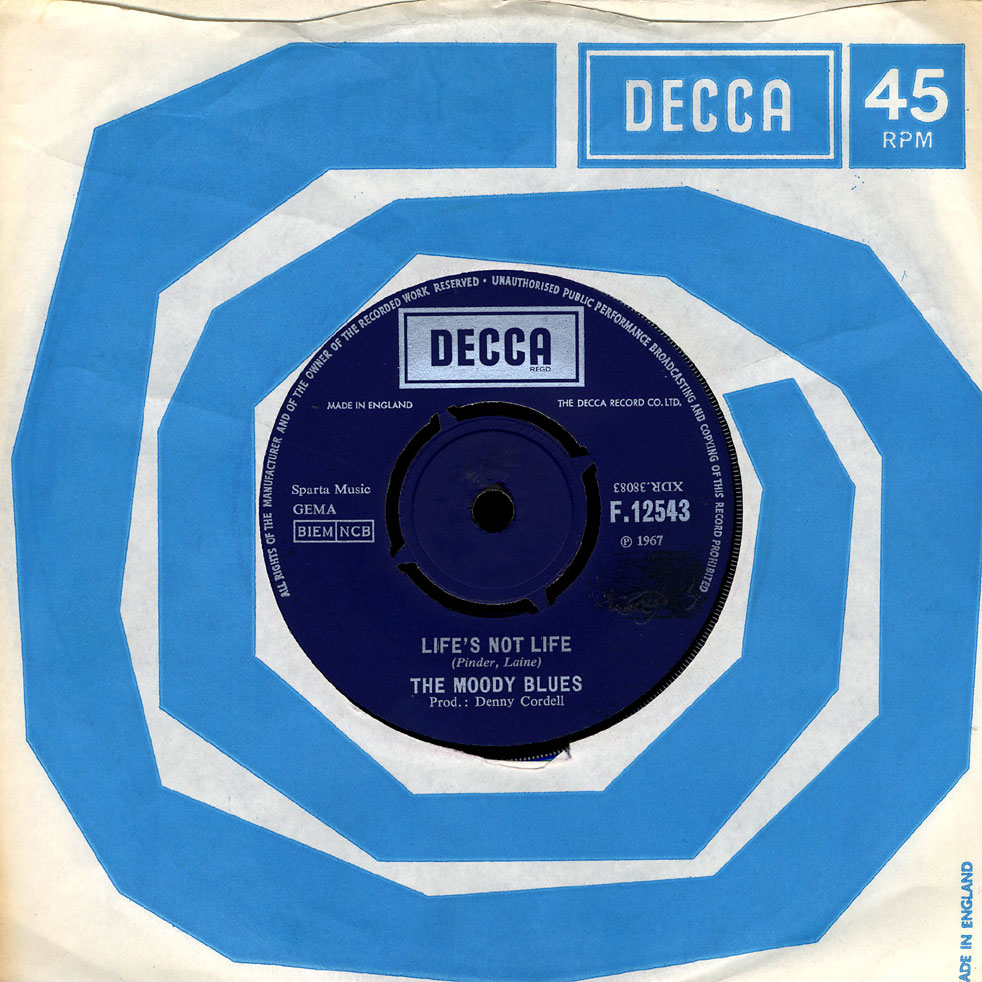

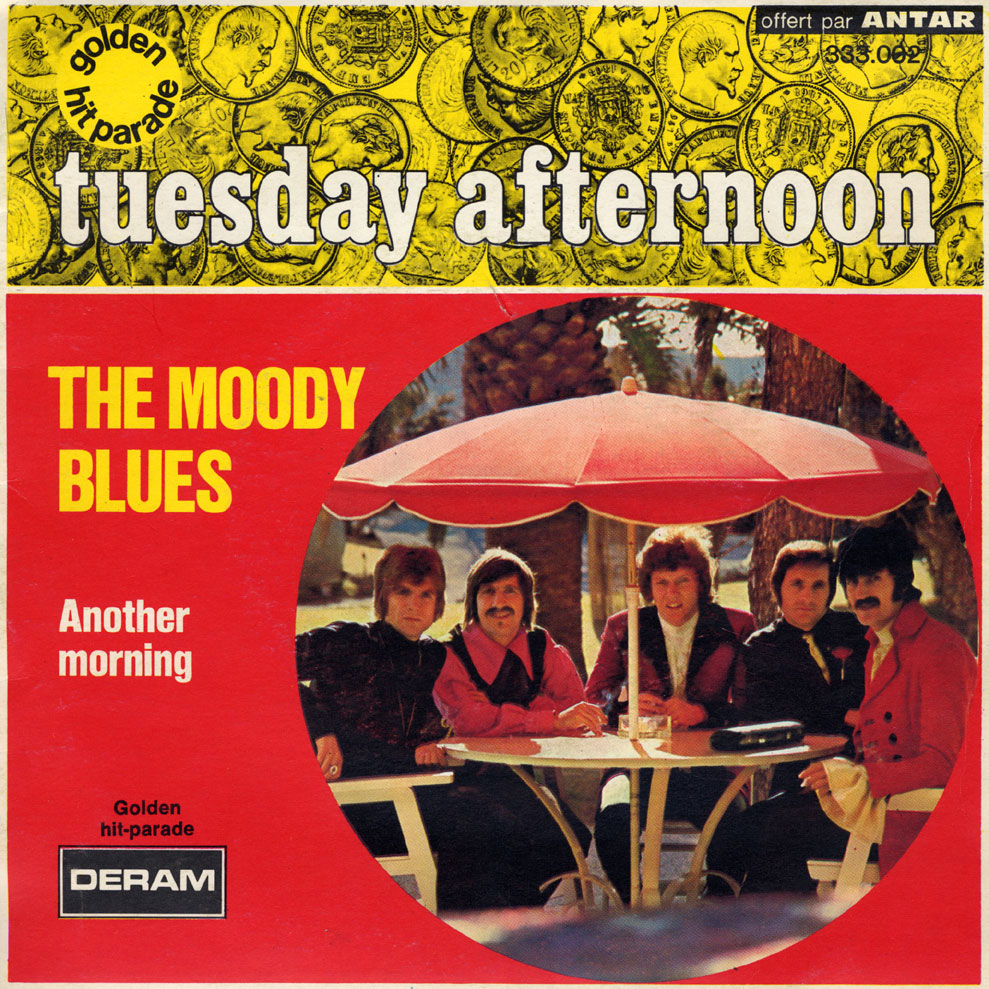
Patrick Moraz came to The Moody Blues from Yes